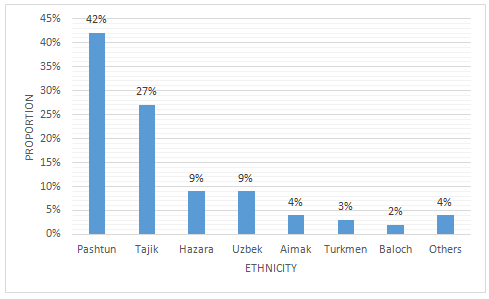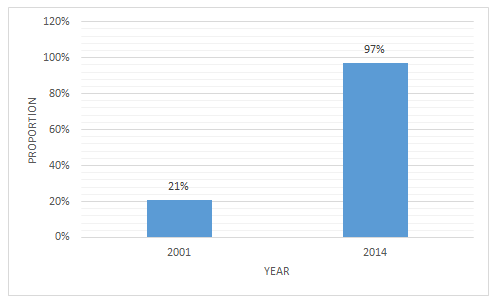АФГАНИСТАН: ОБЗОР ПОСЛЕ РЕЖИМА ТАЛИБАНА
Сармачар П.
Аспирант, Кафедра Политологии, Казанcкий (Приволжский) федеральный университет
АФГАНИСТАН: ОБЗОР ПОСЛЕ РЕЖИМА ТАЛИБАНА
Аннотация
С тех пор как Талибан был свергнут в Афганистане в 2001 с помощью интернациональных сил, страна проходит через социально-экономическое и политическое преобразование, несмотря на проблему различных Исламских террористических групп. Среди достижений после эры Талибана: развитие образования, расширение возможностей женщин, санитария и развитие в системе здравоохранения. Несмотря на неразвитую инфраструктуру к 2012 около 7.8 миллионов учеников зарегистрировались в государственных школах, включая приблизительно 2.9 миллиона девочек. Женщин стали назначать на должности в правительственной работе намного быстрее, чем мужчин. Если эта тенденция будет продолжаться, то к концу 2020 года число женщин на правительстивенных должностях составит более 40%. Талибан больше не находится у власти в Афганистане, но они объединяются национально и на международном уровне под различными именами с теми же побуждениями и целями. Вот почему терроризм все еще рассматривают как наибольшую угрозу созданию стабильного и устойчивого афганского общества.
Ключевые слова: Афганистан, Талибан, настоящее время, ситуация
Sarmachar P.
PhD student, Department of Political Science, Kazan (Volga Region) Federal University
AFGHANISTAN: AN OVERVIEW AFTER THE TALIBAN REGIME
Abstract
Since the Taliban’s were driven away from the power of Afghanistan in 2001 by the help of international forces, the country is going through major socio-economic and political reformation despite of the challenge of different Islamic-terrorist groups. Among the achievements after Taliban era: the educational development, women empowerment, sanitation and development in the health care systems are remarkable. Despite of the poor infrastructure by 2012 total 7.8 million students enrolled in formal school including about 2.9 million of girls. Women were assigned in the government work at a much faster rate than men. If this continued, by the end of 2020, in the government work the proportion of female employee would be more than 40%. Taliban’s are no more in the power of Afghanistan but they are uniting nationally and internationally by different names with the same motives and goals that’s why still terrorism is considered as the major threats for creating stable and sustainable Afghan society.
Keywords: Afghanistan, Taliban, Present, Situation
Introduction
In the political world, Taliban and Afghanistan are the most cited and used word since 1980. The campaign of Taliban traces its descents to the Pakistani-trained mujahedeen in northern Pakistan, in the course of Soviet war in Afghanistan. When Pakistan former prime minister Muhammad Ziaul-ul-Haq feared that the Soviets were planning to invade Baluchistan province of Pakistan. Meanwhile, the United States and Saudi Arabia also involved the encounter against the Soviet Union by providing all of the backings. By the direct support of USA-Saudi alley, Pakistan’s ISI trained almost 90, 000 Afghans including one of the supreme commander of Taliban Mullah Omar [1]. In an interview with ABC News, the ex-Pakistani prime minister and Chief of Army Pervez Musharraf said that western countries, chiefly USA and United Kingdom, had given aid of about 20 billion dollars during the 1980s to Pakistan specifically for training Taliban personnel and providing them with arms and ammunition [2]. In the consequence, Taliban established themselves as an important politico-religious force in Afghanistan and soon after this they come in the power and set Afghanistan as “The Islamic Emirate of Afghanistan” in 1996 before their fall in 2001 [1]. After falling Taliban, Afghanistan is going through a major socio-economic and political reformation.
Taliban Regime: 1996-2001
After coming in power Taliban government were recognized only by Pakistan, Saudi Arabia, and the United Arab Emirates (UAE) [3]. The reasons for lack of international recognition were, soon after coming in power the Taliban and their allies committed massacres against Afghan civilians by the name of sharia law, violation human rights and the rule of law, denied UN food supplies. Taliban regime was also heavily condemned for the assassination of Iranian diplomats in Afghanistan and for their sincere aids for the Islamic militants performing in Chechnya of Russia and Xinjiang of China. The Kabul stock exchange reacted firmly during the first weeks of the Taliban occupation but the currency of Afghanistan soon dropped in value. In 2001 the per head income of the 25 million afghan population was below $200, and the country was near to absolute economic disruption [4]. The education systems especially women education also totally destroyed during Taliban era.
Present Condition
Even though Afghanistan’s continual warfare, Afghans have made visible progress in laying the infrastructures for a more representative state that can fulfill its people’s demands. By the empowerment of Ashraf Ghani as a president in September 2014 Afghanistan has seen its first democratic transfer of power, which is considered as a major political reform in perspective of stable Afghanistan.
Population
Now Afghanistan has a population of about 31.3 million and the growth rate of population also remarkable. Most of the population of Afghanistan constituted of from seven major ethnic groups (Figure 1). Most of the Afghan women get married young and they have in average five children. The birthrate of the country is among the 10th highest birthrate in the world according to CIA The World Factbook [5].
Figure 1 - Ethnic groups of Afghanistan population (Source: The CIA World Factbook) [5]
Capital city Kabul is the major political, business and cultural hub of Afghanistan having a population of about 3.3 million. According to the UN major proportion (76%) of Afghans live in remote rural areas.
Education System
Education systems development is considered as the major success story of Afghanistan, accomplished with international backing since the Taliban’s were driven from the power in 2001.
Figure 2 - Comparison between the enrollment rate (Source: The World Bank) [7]
During Taliban era no girls attended formal school [6]. The literacy rate of Afghanistan is very low (39%), is one of the lowest in the world. But the situation is totally changed now. According to the World Bank, in spite of poor infrastructure by 2012 total 7.8 million students enrolled in formal school including about 2.9 million of girls. World Bank also mentioned that among the 180,000 teachers, only 52% meet the minimum standard required [7]. Still the dropout rates of girls from the formal school is very much high. Figure 2 demonstrates the comparison between children enrollment rate in two different regimes.
Women Empowerment
During the Taliban ruling time women work and education of Afghanistan were totally banned. But thankfully, the situation is improving day by day. According to World Bank, now in Afghanistan 36% girls are enrolled in formal school though most of them couldn’t complete their secondary education. In an another report, World Bank said from 2007 most of the women (52%) get married by the age of 20 [7]. The adult literacy rate among the women are also very low. Central Statistics Organization (CSO)/UNICEF reported that literacy rate of Afghan women among the age of 15-24 is only 22.2% [8]. A matter of hope that in Afghanistan now more than a quarter of parliament and government employees are women on the basis of a report by charity organization Islamic Relief [9]. In 2009 a survey report done by CSO stated that women were assigned in the government work at a much faster rate than men. If this continued, by the end of 2020, in the government work the proportion of female employee would be more than 40% [8]. Now women are also working in the police and army of Afghanistan.
Health Care System
Improvement of the health care systems of Afghanistan is easily visible after Taliban regime. Though, still the country is facing high infant and maternal mortality rates but life expectancy of the afghan peoples is slightly increasing from 56 to 60 years. According to the UN, access to pure drinking water improved from 4.8% of the population to 60.6% by 2011. Access to better sanitation, including private rather than shared toilets, has also improved to an average 37% [10]. But the averages again mask big differences between urban and rural areas, with much less improvement in rural areas. Vaccination campaigns continue to work towards the elimination of polio in Afghanistan, one of the last remaining countries where the disease remains endemic. In 2013 there were 14 reported cases, down from 37 in 2012.
Economic Situation
After Taliban regime, Afghanistan is going through a massive economic reform. Still, Afghanistan's biggest export product is opium - despite attempts to persuade farmers to diversify. In 2013-2014 fiscal year was a record year and the country produces 90% of the world's opium [11]. The tremendous sale price of opium makes it difficult for farmers to resist. They also say promises to provide high-quality seeds and fertilizer have not been kept. Other exports product includes fruit and nuts, handwoven carpets and wool. Import products comprises machinery, food, garments and crude oil products. It is said that Afghanistan is very rich in mineral reserves, including natural gas, which have not been exploited due to the unrest political situation of the country. Afghanistan has one of the lowest rates of energy usage in the world. According to the World Bank only 28% of its population is connected to the national power grid and the service is unreliable [11]. Urban based populations of Afghanistan are more likely to be connected by electricity than the rural and remote area population.
Conclusion
Despite the remarkable advances in different sectors, Afghanistan is still facing different types of challenge including so-called Islamic terrorism. Terrorist are uniting in different names and their international connection is increasing day by day. It has been said that a major proportion of root level uneducated and softminded religious peoples of Afghanistan gives support to the terrorist by the name of saving Islam and the terrorist groups are taking continuous advantages from them. National and international level supports are needed to create a stable social and political condition in Afghanistan. And for developing a sustainable Afghan society there is no alternatives to provide modern education to the Afghan people instead of giving Madrasah based religious education.
References
- Price C. Pakistan: A Plethora Problems. Global Security Studies, School of Graduate and Continuing Studies in Diplomacy. Norwich University, Northfield; 2012. Volume 3(1). Pp: 53-62.
- “Interview with Pervez Musharraf”. ABC News. Retrieved24 July 2015.
- Guelke A. Terrorism and Global Disorder-Google Libros. Books.google.com; 2012. Retrieved 2012-08-15.
- Skaine R. K.Women of Afghanistan in the Post-Taliban Era: How Lives Have Changed and Where They Stand Today. McFarland; 2009. p. 57.
- Central Intelligence Agency: The World Factbook- Afghanistan. Available: https://www.cia.gov/library/publications/the-world-factbook/geos/af.html
- “Education”. United States Agency for International Development (USAID). Retrieved11 August 2011.
- The World Bank: Overview on Afghanistan. Available: http://www.worldbank.org/en/country/afghanistan/overview#1
- Central Statistics Organization: Afghanistan Open Data. Available: http://cso.gov.af/en/page/8142
- Islamic Relief USA: Afghanistan Overview. Available: http://irusa.org/afghanistan
- Edward A et al."Trends in the Quality of Health Care for Children Aged Less than 5 Years in Afghanistan, 2004 - 2006". Bullet World Health Organization; 2009. 940. Retrieved 26 May2012.
- BBC News “Afghanistan: Before and after the Taliban”, 2 April 2014, Available: http://www.bbc.com/news/world-asia-26747712


